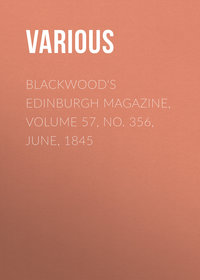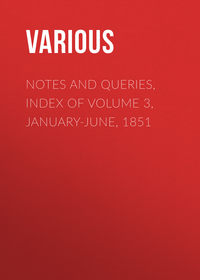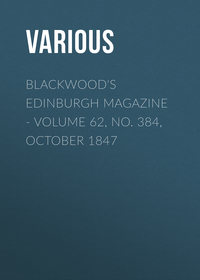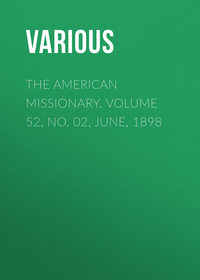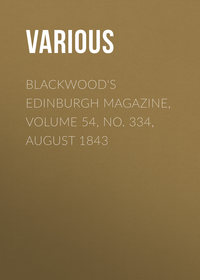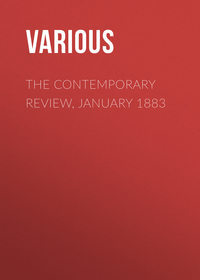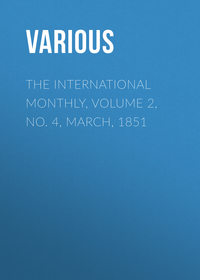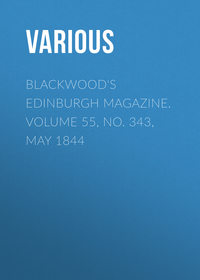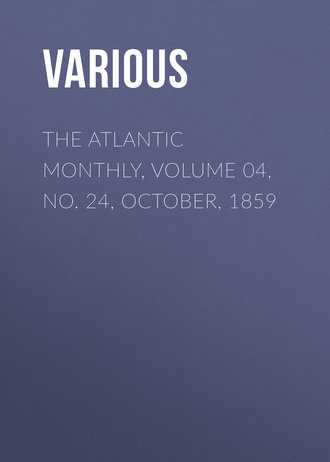 полная версия
полная версияThe Atlantic Monthly, Volume 04, No. 24, October, 1859
3
For instance, the movements of ballet-dancers, except the very artificial ones of the feet and hands.
4
Thus, it is the office of a bonnet or a hat to protect the head and face; and so a sun-shade carried by the wearer of a bonnet is a confession that the bonnet is a worthless thing, worn only for show: but an umbrella is no such confession; because it is not the office of the hat or bonnet to shelter the whole person from sun or rain.
5
Instructions to Young Marksmen in all that relates to the General Construction, Practical Manipulation, etc., etc., as exhibited in the Improved American Rifle. By John Ratcliffe Chapman, C. E. New York: D. Appleton &. Co. 1848.
Rifle-Practice. By Lieut.-Col. John Jacob, C. B., of the Bombay Artillery. London: Smith, Elder, & Co. 1857.
The Rifle; and how to use it. Comprising a Description of that Admirable Weapon, etc., etc. By Hans Busk, M.A. First Lieut. Victoria Rifles. London: J. Routledge & Co. 1858.
Report of the U. S. Commission on Rifles. 1856.
6
Robins {on Projectiles) said in 1748, "Whatever state shall thoroughly comprehend the nature and advantages of rifle-pieces, and, having facilitated and completed their construction, shall introduce into their armies their general use, with a dexterity in the management of them, will by this means acquire a superiority which will almost equal anything that has been done at any time by the particular excellence of any one kind of arms, and will perhaps fall but little short of the wonderful effects which histories relate to have been formerly produced by the first inventors of fire-arms." Words, we now see, how prophetic!
7
The technical name for the long, heavy, small-calibred rifle, in which the thickness of the metal outside the bore is about equal to the diameter of the bore.
8
A man, five feet ten inches high, at 1450 yards, will, in the buck-sight of the Minie rifle, at fourteen inches from the eye, appear 1/53 of an inch in height and 1/185 in breadth of shoulders. If the reader will look at these measures on a finely divided scale, he will appreciate the absurdity of such a boast. A man at that distance could hardly be found in the sights.
9
Experiments have shown, that, with a barrel about the thickness of that of our "regulation rifles," the spring will throw a ball nearly two feet from the aim in a range of six hundred yards, if the barrel be firmly held in a machine.
10
There is much difference of opinion amongst gun-makers as to the length of barrel most desirable. We believe in a long barrel, for the following reasons: 1st, a longer distance between sights is given, and the back sight can be put farther from the eye, so that finer sighting is possible; 2d, a long barrel is steadier in off-hand shooting; 3d, it permits a slower powder to be used, so that the ball starts more slowly and yet allows the full strength of the powder to be used before it leaves the barrel, getting a high initial velocity with little recoil, and without "upsetting" the ball, as we shall explain farther on. The experiments of the United States government show that the increasing of the length of the barrel from thirty-three to forty inches (we speak from memory as to numbers) increased the initial velocity fifty feet per second; but this will, in long ranges, be no advantage, except with such a shape of missile as will maintain a high speed.
11
Hunters still dispute as to iron or steel; and we have used iron barrels made by Amsden, of Saratoga Springs, which for accuracy and wear were unexceptionable; though gunsmiths generally take less pains with iron than steel barrels. But give us steel.
12
This is a fact,—denied, of course, by some of the Roman Catholics, in argument; for what will they not deny? But it is, nevertheless, a fact. I have now before me a little Catechism, from which the Second Commandment is omitted, and the Tenth divided into two; and I have examined others in which the same omission is made. I cannot say that all are in the same category; for the Catholic Church is everything to everybody; but I can assert it of all I have seen, and especially of La Dottrina Xtiana, compilata per Ordine dell Eminentissinto Cardinale GONZAGA MEMBRINI, Vescovo di Ancona, per l'Uso delict Citta e Diocesi, published in 1830, which I mention because it is a compilation of authority, made under the superintendence of the Cardinal Bishop of Ancona,—and of the Catechismo per i Fanciulll, ad Uso delle Città e Diocesi di Cortona, Chiuso, Pienza, Pistoia, Prato e Colle, published in 1786, under the auspices and with the approval of the bishops of all these cities and dioceses.
13
This festival of San Giuseppe, which takes place on the 19th of March, bears a curious resemblance to the Liberalia of the ancient Romans, a festival in honor of Bacchus, which was celebrated every year on the 17th of March, when priests and priestesses, adorned with garlands of ivy, carried through the city wine, honey, cakes, and sweetmeats, together with a portable altar, in the middle of which was a small fire-pan, (foculus,) in which, from time to time, sacrifices were burnt. The altar has now become a booth, the foculus a caldron, the sacrifices are of little fishes as well as of cakes, and San Giuseppe has taken the place of Bacchus, Liber Pater; but the festivals, despite these differences, have such grotesque points of resemblance that the latter looks like the former, just as one's face is still one's face, however distortedly reflected in the bowl of a spoon; and, perhaps, if one remembers the third day of the Anthesteria, when cooked vegetables were offered in honor of Bacchus, by putting it together with the Liberalia, we shall easily get the modern festa of San Giuseppe.
14
Beside the blessing of the eggs and house, it is the custom in some parts of Italy, (and I have particularly observed it in Siena,) for the priest, at Easter, to affix to the door of the chief palazzi and villas a waxen cross, or the letter M in wax, so as to guard the house from evil spirits. But only the houses of the rich are thus protected; for the priests bestow favors only "for a consideration," which the poor cannot so easily give.
15
See Shakespeare's Scholar, p. 71.
16
See the London Athenaeum, of Nov. 20th, 1858, and Jan. 8th, 1859.] It is true, that, when, in his recent edition of Shakespeare's Works
17
London, 1858, Vol. II, p. 181.
18
Rimbault's Edition of Overbury's Works, London, 1856, p. 50.
19
See Dyce's Strictures etc., 1859, p. 28.
20
See the edition passim.
21
Strictures on Collier's Shakespeare, London, 1859
22
This memorandum is characteristic. In full it is as follows:—
"Sept: the 9th: Cloathes: 1. Shirt: 3: bands: 8 handkecheirfs: 4 neckcloaths: 7: pa: cuffs: 1. bootes tops: 1 cap: an old towell: a Napkin."
The writer was evidently young, poor, and a dandy. His youth is shown by his wearing neckcloths, which were a new and youthful fashion at the date of this memorandum; his dandyism, by the number of his handkerchiefs, (a luxury in those days,) and of his cuffs, which answer to our wristbands, and by his lace boot-tops; his poverty, by his wearing three bands, four neckcloths, and seven pair of cuffs (probably one a day for the week) to one shirt. His having, in respect to the last garment, was probably like Poins'
23
"one for superfluity and one other for use." The cap was probably that which he wore when he laid aside his wig. His hose, of colored silk, probably made only "semi-occasional" visits to the laundress.
24
See As You Like It, in the folio of 1623, p. 196, col. 2, "I answer you right painted cloath," and Henry VIII., Idem, p. 224, col. 2, "They that beare the Cloath of Honour ouer her."


